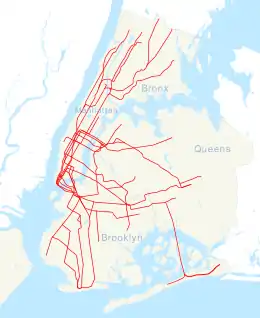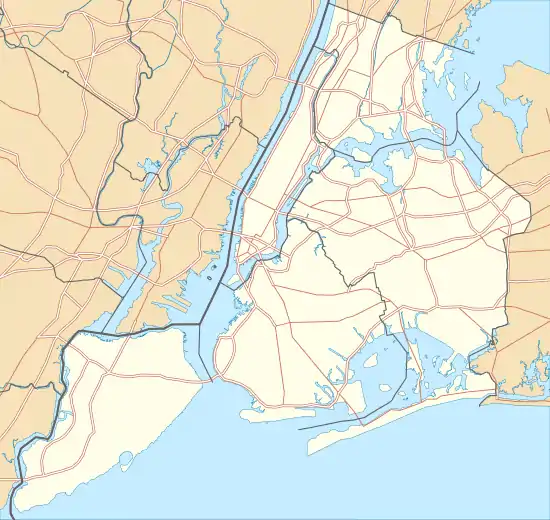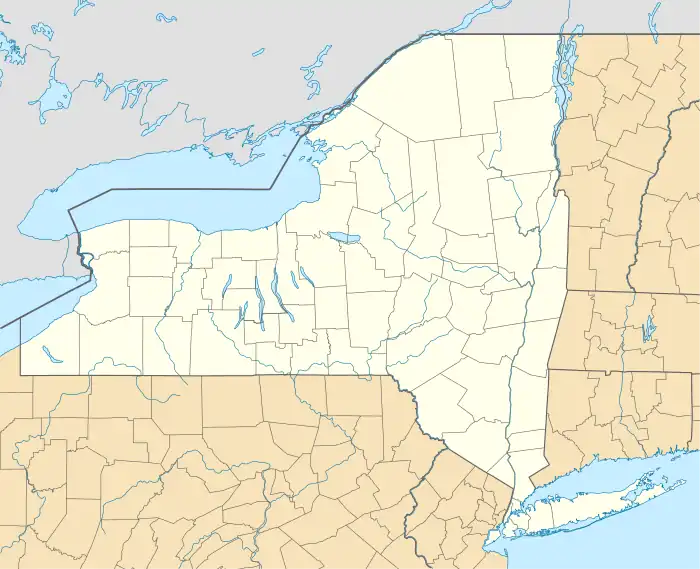Hunters Point Avenue | |||||||||||||||||||||||||||||||||||||||||||||||||||||||||||||||||||||||||||||||||||||||||
|---|---|---|---|---|---|---|---|---|---|---|---|---|---|---|---|---|---|---|---|---|---|---|---|---|---|---|---|---|---|---|---|---|---|---|---|---|---|---|---|---|---|---|---|---|---|---|---|---|---|---|---|---|---|---|---|---|---|---|---|---|---|---|---|---|---|---|---|---|---|---|---|---|---|---|---|---|---|---|---|---|---|---|---|---|---|---|---|---|---|
 | |||||||||||||||||||||||||||||||||||||||||||||||||||||||||||||||||||||||||||||||||||||||||
| Station statistics | |||||||||||||||||||||||||||||||||||||||||||||||||||||||||||||||||||||||||||||||||||||||||
| Address | 49th Avenue & 21st Street Queens, NY 11101 | ||||||||||||||||||||||||||||||||||||||||||||||||||||||||||||||||||||||||||||||||||||||||
| Borough | Queens | ||||||||||||||||||||||||||||||||||||||||||||||||||||||||||||||||||||||||||||||||||||||||
| Locale | Hunters Point, Long Island City | ||||||||||||||||||||||||||||||||||||||||||||||||||||||||||||||||||||||||||||||||||||||||
| Coordinates | 40°44′32.57″N 73°56′57.33″W / 40.7423806°N 73.9492583°W | ||||||||||||||||||||||||||||||||||||||||||||||||||||||||||||||||||||||||||||||||||||||||
| Division | A (IRT)[1] | ||||||||||||||||||||||||||||||||||||||||||||||||||||||||||||||||||||||||||||||||||||||||
| Line | IRT Flushing Line | ||||||||||||||||||||||||||||||||||||||||||||||||||||||||||||||||||||||||||||||||||||||||
| Services | 7 | ||||||||||||||||||||||||||||||||||||||||||||||||||||||||||||||||||||||||||||||||||||||||
| Transit | |||||||||||||||||||||||||||||||||||||||||||||||||||||||||||||||||||||||||||||||||||||||||
| Structure | Underground | ||||||||||||||||||||||||||||||||||||||||||||||||||||||||||||||||||||||||||||||||||||||||
| Platforms | 2 side platforms | ||||||||||||||||||||||||||||||||||||||||||||||||||||||||||||||||||||||||||||||||||||||||
| Tracks | 2 | ||||||||||||||||||||||||||||||||||||||||||||||||||||||||||||||||||||||||||||||||||||||||
| Other information | |||||||||||||||||||||||||||||||||||||||||||||||||||||||||||||||||||||||||||||||||||||||||
| Opened | February 15, 1916 | ||||||||||||||||||||||||||||||||||||||||||||||||||||||||||||||||||||||||||||||||||||||||
| Opposite- direction transfer | Yes | ||||||||||||||||||||||||||||||||||||||||||||||||||||||||||||||||||||||||||||||||||||||||
| Former/other names | 49th Avenue | ||||||||||||||||||||||||||||||||||||||||||||||||||||||||||||||||||||||||||||||||||||||||
| Traffic | |||||||||||||||||||||||||||||||||||||||||||||||||||||||||||||||||||||||||||||||||||||||||
| 2022 | 1,038,309[2] | ||||||||||||||||||||||||||||||||||||||||||||||||||||||||||||||||||||||||||||||||||||||||
| Rank | 273 out of 423[2] | ||||||||||||||||||||||||||||||||||||||||||||||||||||||||||||||||||||||||||||||||||||||||
| |||||||||||||||||||||||||||||||||||||||||||||||||||||||||||||||||||||||||||||||||||||||||
| |||||||||||||||||||||||||||||||||||||||||||||||||||||||||||||||||||||||||||||||||||||||||
| |||||||||||||||||||||||||||||||||||||||||||||||||||||||||||||||||||||||||||||||||||||||||
| |||||||||||||||||||||||||||||||||||||||||||||||||||||||||||||||||||||||||||||||||||||||||
| |||||||||||||||||||||||||||||||||||||||||||||||||||||||||||||||||||||||||||||||||||||||||
The Hunters Point Avenue station is a station on the IRT Flushing Line of the New York City Subway. Located at 49th Avenue (formerly Hunters Point Avenue) and 21st Street in the intersections of Hunters Point and Long Island City, Queens, it is served by the 7 train at all times and the <7> train during rush hours in the peak direction.
History
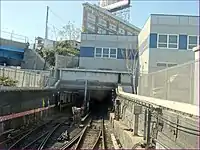
As part of its development, what is now the Flushing Line was extended one stop East, from Vernon–Jackson Avenues, which opened in 1915, to Hunters Point Avenue on February 15, 1916.[3] Later that year it would again be extended to Court Square–23rd Street station.
The city government took over the IRT's operations on June 12, 1940.[4][5] The IRT routes were given numbered designations in 1948 with the introduction of "R-type" rolling stock, which contained rollsigns with numbered designations for each service.[6] The route from Times Square to Flushing became known as the 7.[7] In 1949, the New York City Board of Transportation announced that the Flushing Line platforms would be lengthened to 11 IRT car lengths; the platforms were only able to fit nine 51-foot-long IRT cars beforehand.[8][9] The platforms at the station were extended in 1955–1956 to accommodate 11-car trains.[10] However, nine-car trains continued to run on the 7 route until 1962, when they were extended to ten cars.[11]
Station layout
| Ground | Street level | Entrances/exits |
| Mezzanine | Station agent, MetroCard vending machines | |
| Platform level | Side platform | |
| Southbound | ← | |
| Northbound | | |
| Side platform | ||
This station is the easternmost (railroad north) underground station on the Flushing Line until the northbound terminal station (Flushing – Main Street). The tunnel portal is at the eastern end of the station. Just outside the portal is a diamond crossover linking the two tracks.
This station has two tracks and two side platforms. Its architecture is in an Italianate design of brown color. Tilework includes a trimline with "HP" tiles on it and name tablets reading "HUNTERS POINT AVE." in gold serif font. The platform columns also have a trim line with "HP" tiles below them.
Exits
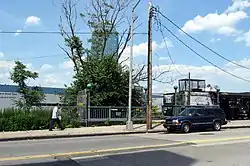
This station has one fare control area above the platforms and tracks near the north end. Two staircases from each platform go up to a waiting area/crossover, where a turnstile bank and several exit–only turnstiles provide access to and from the station. Outside fare control, there is a token booth and one staircase going up to the north side of 49th Avenue with 21st Street several hundred yards to the west. Two other staircases to the east go up to the north side of the same street and is near the Long Island Rail Road's Hunterspoint Avenue station.[12]
On October 29, 1982, a public hearing was scheduled concerning the planned closure of the entrance leading to the southeast corner of 49th Avenue and 21st Street as part of the New York City Transit Authority's Station Modernization Program.[13]
References
- ↑ "Glossary". Second Avenue Subway Supplemental Draft Environmental Impact Statement (SDEIS) (PDF). Vol. 1. Metropolitan Transportation Authority. March 4, 2003. pp. 1–2. Archived from the original (PDF) on February 26, 2021. Retrieved January 1, 2021.
- 1 2 "Annual Subway Ridership (2017–2022)". Metropolitan Transportation Authority. 2022. Retrieved November 8, 2023.
- ↑ "SUBWAY EXTENSION OPEN.; Many Use New Hunters Point Avenue Station" (PDF). Retrieved August 31, 2016.
- ↑ "City Transit Unity Is Now a Reality; Title to I.R.T. Lines Passes to Municipality, Ending 19-Year Campaign". The New York Times. June 13, 1940. ISSN 0362-4331. Archived from the original on January 7, 2022. Retrieved May 14, 2022.
- ↑ "Transit Unification Completed As City Takes Over I. R. T. Lines: Systems Come Under Single Control After Efforts Begun in 1921; Mayor Is Jubilant at City Hall Ceremony Recalling 1904 Celebration". New York Herald Tribune. June 13, 1940. p. 25. ProQuest 1248134780.
- ↑ Brown, Nicole (May 17, 2019). "How did the MTA subway lines get their letter or number? NYCurious". amNewYork. Archived from the original on March 2, 2021. Retrieved January 27, 2021.
- ↑ Friedlander, Alex; Lonto, Arthur; Raudenbush, Henry (April 1960). "A Summary of Services on the IRT Division, NYCTA" (PDF). New York Division Bulletin. Electric Railroaders' Association. 3 (1): 2–3. Archived (PDF) from the original on September 14, 2020. Retrieved January 27, 2021.
- ↑ Bennett, Charles G. (November 20, 1949). "Transit Platforms On Lines In Queens To Be Lengthened; $3,850,000 Program Outlined for Next Year to Care for Borough's Rapid Growth New Links Are To Be Built 400 More Buses to Roll Also — Bulk of Work to Be on Corona-Flushing Route Transit Program In Queens Outlined". The New York Times. ISSN 0362-4331. Retrieved April 29, 2018.
- ↑ "37 Platforms On Subways To Be Lengthened: All Stations of B. M. T. and I.R.T.in Queens Included in $5,000,000 Program". New York Herald Tribune. November 20, 1949. p. 32. ISSN 1941-0646. ProQuest 1325174459.
- ↑ Minutes and Proceedings of the New York City Transit Authority. New York City Transit Authority. 1955. Archived from the original on September 13, 2020. Retrieved August 31, 2016.
- ↑ "R17s to the Flushing Line". New York Division Bulletin. Electric Railroaders' Association. 5 (6): M-8. December 1962 – via Issuu.
- ↑ "MTA Neighborhood Maps: Long Island City" (PDF). Metropolitan Transportation Authority. 2015. Retrieved September 27, 2015.
- ↑ "Notice of Public Hearing". New York Daily News. September 21, 1982. Retrieved December 16, 2018.
External links
 Media related to Hunters Point Avenue (IRT Flushing Line) at Wikimedia Commons
Media related to Hunters Point Avenue (IRT Flushing Line) at Wikimedia Commons- nycsubway.org – IRT Flushing Line: Hunterspoint Avenue
- Station Reporter — 7 Train
- The Subway Nut — Hunters Point Avenue Pictures
- Hunters Point Avenue entrance from Google Maps Street View
- Platforms from Google Maps Street View
